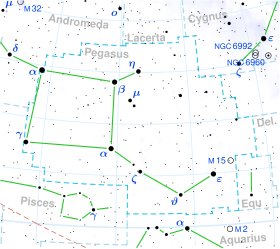| Observation data Epoch J2000 Equinox J2000 | |
|---|---|
| Constellation | Pegasus |
| Right ascension | 21h 29m 56.89545s [1] |
| Declination | 23° 38′ 19.8170″ [1] |
| Apparent magnitude (V) | 4.52 [2] |
| Characteristics | |
| Evolutionary stage | AGB [3] |
| Spectral type | M1+III [4] |
| U−B color index | +1.93 [5] |
| B−V color index | +1.62 [5] |
| Astrometry | |
| Radial velocity (Rv) | −18.92 [6] km/s |
| Proper motion (μ) | RA: +24.74 [1] mas/yr Dec.: +3.63 [1] mas/yr |
| Parallax (π) | 8.28±0.18 mas [1] |
| Distance | 394 ± 9 ly (121 ± 3 pc) |
| Absolute magnitude (MV) | −0.89 [2] |
| Details | |
| Mass | 1.2 [7] M☉ |
| Radius | 55 [8] R☉ |
| Luminosity | 646 [9] L☉ |
| Surface gravity (log g) | 1.57 [7] cgs |
| Temperature | 3,921 [9] K |
| Metallicity [Fe/H] | −0.16 [7] dex |
| Other designations | |
| 2 Peg, NSV 25624, BD+23°4325, FK5 1565, GC 30109, HD 204724, HIP 106140, HR 8225, SAO 89752, CCDM J21299+2338A, WDS J21299+2338A [10] | |
| Database references | |
| SIMBAD | data |
2 Pegasi is a single [11] star in the constellation Pegasus, located approximately 394 light years away from the Sun based on parallax. [1] It is visible to the naked eye as a faint, red-hued star with an apparent visual magnitude of 4.52. [2] The object is moving closer to the Earth with a heliocentric radial velocity of −19 km/s. [6] It has a magnitude 12.7 visual companion, designated component B, at an angular separation of 30.4″ . [12]
This is an aging red giant star with a stellar classification of M1+III, [4] currently on the asymptotic giant branch, [3] having exhausted the hydrogen at its core and evolved away from the main sequence. The star has expanded to an estimated 55 times the radius of the Sun. [8] It is radiating 646 times the luminosity of the Sun from its enlarged photosphere at an effective temperature of 3,921 K .
